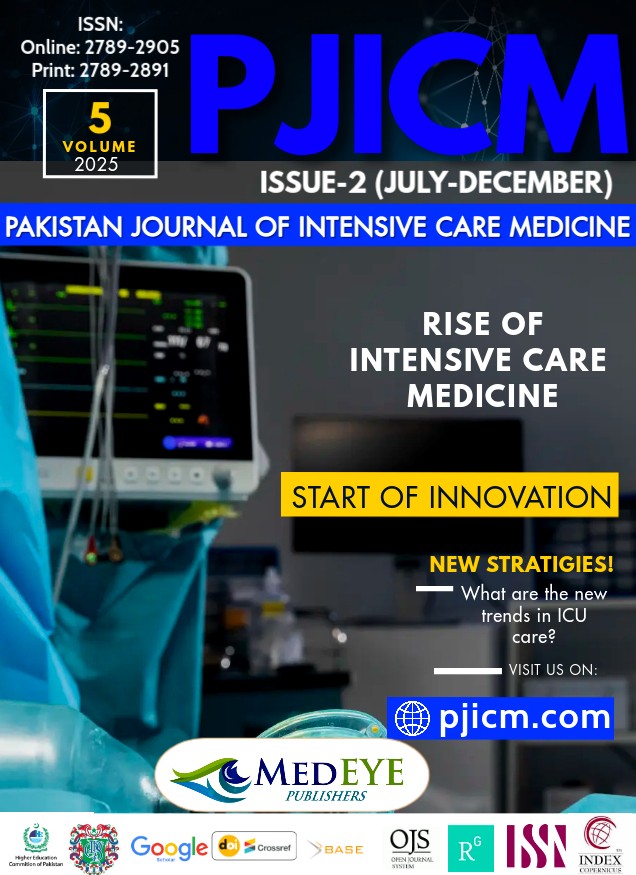VISUAL OUTCOME IN DIABETIC PATIENTS UNDERGOING PARS PLANA VITRECTOMY FOR VITREOUS HEMORRHAGE
DOI:
https://doi.org/10.54112/pjicm.v5i02.197Keywords:
Pars Plana Vitrectomy, Diabetic Retinopathy, Vitreous Haemorrhage, Visual Acuity, LogMAR, Postoperative ComplicationsAbstract
Background: Vitreous hemorrhage is a significant cause of visual impairment among patients with diabetic retinopathy. Pars plana vitrectomy (PPV) remains the primary treatment for restoring visual function; however, outcomes are influenced by multiple systemic and postoperative factors. Objective: To assess the visual outcomes of diabetic patients following PPV for vitreous hemorrhage and to determine the association of postoperative improvement with clinical variables. Study Design: Prospective observational study. Setting: Department of Ophthalmology, Hayatabad Medical Complex, Peshawar, Pakistan. Duration of Study: 01-January-2025 to 01-July-2025. Methods: A total of 73 diabetic patients indicated for PPV due to vitreous hemorrhage were included. Preoperative best-corrected visual acuity (BCVA) was recorded using the Snellen chart and converted to LogMAR. Standard PPV was performed in all participants. Postoperative follow-up was conducted for 3 months to assess final BCVA and monitor complications such as recurrent vitreous hemorrhage, cataract progression, raised intraocular pressure, and retinal detachment. Data were analyzed using SPSS version 25, and p-values ≤ 0.05 were considered statistically significant. Results: The mean age of patients was 56.11 ± 7.79 years, and males accounted for 65.8% of the study population. A considerable improvement was noted in BCVA from 1.60 ± 0.28 LogMAR preoperatively to 0.94 ± 0.31 LogMAR postoperatively (p = 0.0001). A postoperative BCVA better than 1.0 LogMAR was achieved in 64.4% of patients. Recurrent vitreous hemorrhage occurred in 2.7% and elevated intraocular pressure in 9.6% of patients. Increased age (>55 years), hypertension, and postoperative complications were significantly linked with poorer visual outcomes. Conclusion: PPV substantially improves visual acuity in diabetic patients with vitreous hemorrhage. Factors such as advanced age, comorbid hypertension, and postoperative complications negatively influence final vision. Early intervention and proper systemic management may further enhance visual recovery.
References
Fung TH, Patel B, Wilmot EG, Amoaku WM. Diabetic retinopathy for the non-ophthalmologist. Clin Med (Lond). 2022;22(2):112-6. https://doi.org/10.7861/clinmed.2021-0792
Lundeen EA, Burke-Conte Z, Rein DB, Wittenborn JS, Saaddine J, Lee AY, et al. Prevalence of diabetic retinopathy in the US in 2021. JAMA Ophthalmol. 2023;141(8):747-54. https://doi.org/10.1001/jamaophthalmol.2023.2038
Arrigo A, Aragona E, Bandello F. VEGF-targeting drugs for the treatment of retinal neovascularization in diabetic retinopathy. Ann Med. 2022;54(1):1089-1111. https://doi.org/10.1080/07853890.2022.2064541
Bucolo C, Barbieri A, Viganò I, Marchesi N, Bandello F, Drago F, et al. Short and long term expression of VEGF: temporal regulation of a key factor in diabetic retinopathy. Front Pharmacol. 2021;12:707909. https://doi.org/10.3389/fphar.2021.707909
Jorge DM, Tavares Neto JE, Poli-Neto OB, Scott IU, Jorge R. Intravitreal bevacizumab versus bevacizumab in combination with pars plana vitrectomy for vitreous hemorrhage secondary to proliferative diabetic retinopathy: a randomized clinical trial. Int J Retina Vitreous. 2021;7(1):35. https://doi.org/10.1186/s40942-021-00296-7
Schreur V, Brouwers J, van Huet RA, Smeets S, Phan M, Hoyng CB, et al. Long term outcomes of vitrectomy for proliferative diabetic retinopathy. Acta Ophthalmol. 2021;99(1):83-9. https://doi.org/10.1111/aos.14408
Zhang ZH, Liu HY, Hernandez-Da Mota SE, Romano MR, Falavarjani KG, Ahmadieh H, et al. Vitrectomy with or without preoperative intravitreal bevacizumab for proliferative diabetic retinopathy: a meta-analysis of randomized controlled trials. Am J Ophthalmol. 2013;156(1):106-15. https://doi.org/10.1016/j.ajo.2013.02.008
Nakao S, Ishikawa K, Yoshida S, Kohno RI, Miyazaki M, Enaida H, et al. Altered vascular microenvironment by bevacizumab in diabetic fibrovascular membrane. Retina. 2013;33(5):957-63. https://doi.org/10.1097/IAE.0b013e3182753b41
Evoy KE, Abel SR. Ranibizumab: the first vascular endothelial growth factor inhibitor approved for the treatment of diabetic macular edema. Ann Pharmacother. 2013;47(6):811-8. https://doi.org/10.1345/aph.1S013
Ding Y, Yao B, Hang H, Ye H. Multiple factors in the prediction of risk of recurrent vitreous haemorrhage after sutureless vitrectomy for non-clearing vitreous haemorrhage in patients with diabetic retinopathy. BMC Ophthalmol. 2020;20(1):292. https://doi.org/10.1186/s12886-020-01532-8
Shaikh N, Srishti R, Khanum A, Mb T, Dave V, Arora A, et al. Vitreous hemorrhage: causes, diagnosis, and management. Indian J Ophthalmol. 2023;71(1):28-38. https://doi.org/10.4103/ijo.IJO_1884_22
Hoerauf H, Brüggemann A, Muecke M, Lüke J, Müller M, Stefánsson E, et al. Pars plana vitrectomy for diabetic macular edema: internal limiting membrane delamination versus posterior hyaloid removal. A prospective randomized trial. Graefes Arch Clin Exp Ophthalmol. 2011;249(7):997-1008. https://doi.org/10.1007/s00417-010-1610-8
Sultan S, Shakeel A, Khanzada MA, Zaman Y, Kamil Z, Waris N. Surgical outcomes of vitrectomy in patients with complications of diabetic retinopathy at a tertiary care center. J Liaquat Uni Med Health Sci. 2021;20(3):187-92. https://doi.org/10.22442/jlumhs.2021.00843
Haseeb U, Haseeb M, Hadi A, Haseeb S, Mahmood T. Surgical outcomes of pars plana vitrectomy in added and prognostic factors for poor visual outcomes. J Rawalpindi Med Coll. 2025;29(2). https://doi.org/10.37939/jrmc.v29i2.2793
Abdelkader M, Shahin MM, Nwara OL. Function evaluation of diabetic vitreous hemorrhage after vitrectomy. J Ophthalmol Res Rev Rep. 2023;4(1):1-8. https://doi.org/10.47363/JORRR/2022(4)140
Haseeb U, Rehman A, Haseeb M. Visual outcomes of pars plana vitrectomy alone or with intravitreal bevacizumab in patients of diabetic vitreous haemorrhage. J Coll Physicians Surg Pak. 2019;29(8):728-31. https://doi.org/10.29271/jcpsp.2019.08.728
Wattoo RR, Iqbal U, Hameed Z. Surgical outcomes of 23 gauge pars plana vitrectomy for non-clearing diabetic vitreous hemorrhage. J Fatima Jinnah Med Univ. 2023;17(2):45-8. https://doi.org/10.37018/JFJMU/ZEE/1997
Nisic F, Pidro Gadzo A, Fajkic A, Nisic A, Pidro Miokovic A, Damjanovic G, et al. Predictors of visual outcome after pars plana vitrectomy secondary to proliferative diabetic retinopathy. Rom J Ophthalmol. 2023;67(3):283-8. https://doi.org/10.22336/rjo.2023.46
Downloads
Published
How to Cite
Issue
Section
License
Copyright (c) 2025 BK ORAKZAI , S JAN , A ULLAH , MA KHAN , A KHAN

This work is licensed under a Creative Commons Attribution-NonCommercial 4.0 International License.












